I’m not gonna lie, downhill skating can be hard work, especially if you don’t know what you’re doing. It’s easy to end up doing the same thing over and over at sessions, without making any real progress. Unfortunately, that may feel familiar to a lot of you.
So in today’s article, I’ll be writing out a few tips you can follow to help get your progress out of stagnation. Some of the tips are fairly easy to follow, but others are smidge harder. But after reading them, you’ll have a few actionable ideas you can take to improve your skating.
A few tips for beginner downhill skaters
Warm up!
You can’t just go from 0-100 immediately. Take it easy for the first few laps/slides and build it up from there. Let your body warm up and get loose.
You don’t pick up a new session from where you left the old one
The one mistake I see people do, is trying to pick up where they left off from the last session. What they don’t realize is that the last few laps of the previous session were built on the trial and error of everything they did earlier in that given session. They were fully warmed up, they had gotten accustomed to getting into those sliding positions, and their mind had become familiar with what they had been practicing.
In summary, you can’t pick up a new session where you left the old one. You need to warm up and skate a bit so you can familiarize yourself with what you’re doing. Especially as a beginner.
Skating cold can be risky
If anything, skating when you’re cold is dangerous – your ankles are stiff and you can’t balance properly on your board. You’re all stiff and it’s awkward and hard to get into those slide positions, You might not even remember how grippy or icy your wheels were.
It can certainly be a recipe for disaster and you don’t want to add another layer of risk to our already sketchy sport.
So yes. On this new session/new day, your body is cold and needs a nudge to remember some things. Take it easy the first few slides/laps and even do some dynamic stretches (not static stretches) to help loosen up your body. It will go a long way to improve the quality of your sessions, your consistency as a skater and make it a tiny smidge safer for you.
Falling is inevitable, so get padded up
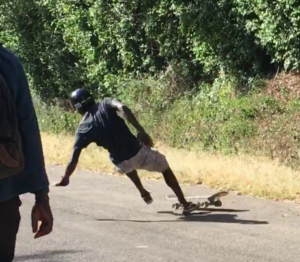
You’re going to fall on your ass, it’s a given. I mean, you’re learning a whole new skill and trying new things that will feel fairly awkward to you. So yes. You will fall.
The wise thing is to get padded up so you can fall again and again, and walk away with only your ego bruised.
Being able to walk away from a fall is important. Injuries and getting hurt really slows your progress as a learner.
But that said, a lot of protective gear is bulky and honestly sucks to wear. But fortunately, there is some gear that is low profile and comfortable to wear, you just need to know which ones to get.
For beginners, I suggest a set of:
- Hard cap knee pads – the TSG DHP, Smith Scabs and Triple 8 knee pads (budget option) are good options
- Low profile elbow pads – Demon D3o (for heavier riders), G-form Elbow pads (for lighter riders) and Triple 8 Exoskin pads are good options
- Hip pads (protect your ass and hips) – Good options available from G-form, Triple 8, Hillbilly etc. Check out the G-form options here on the Stoked ride shop website.
Icy, round lipped freeride wheels are best for learning
It is contestable which are the best wheels for learning to slide, but I believe that icey wheels work the best as your first set of wheels.
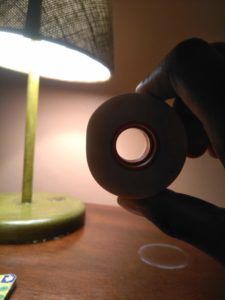
They last long and they breakout really easy. They don’t get flat spots or oval as easily as other wheels do. That said, they aren’t as controllable and it will be tough for you to get your slides under 90* with them. However, the important thing is that you will be getting used to the feeling of sliding, and be able to pull them off really easily. They help build an important part of your fundamentals.
A good example of these wheels is the Powell Peralta Snakes.
Once you feel like you’ve got to grips with those wheels. You should look for a slightly less round lipped, slightly grippier wheel. They will help you learn to control your slides, though they may flat spot a little bit easier.
A word of warning – when you start learning you will (with 99% certainty) flat spot whichever wheels you are using. So don’t feel bad about it. This is something almost every longboarder has gone through.
Don’t invest in cheap gear
Nothing will make you enjoy skating less than low-quality gear. Cheap is certainly expensive in this sport and cheaping out on wheels trucks and a deck will just give you a poor quality skating experience.
Cheap wheels suck at sliding, cheap trucks don’t turn smoothly and they can even cause you to wobble at speed. Cheap decks break easily and don’t feel good underfoot. The same goes with cheap protective gear – which could even fail on you when you need them most.
Simply bear the cost and buy quality gear. It will go a long way to improving your skate experience, how fast you learn and keep you sufficiently protected.
Skate every day! … or often
The best thing you can do to improve your balance and overall skating, is to simply skate every day. Crazy solution right?
Now I don’t mean downhill, but just skating in general.
If you can, I highly suggest you get a cruiser you can use every day. You can use it to commute, to go with to the store, to have a relaxing cruiser to unwind etc. Just figure out how to fit it in your everyday life.
Riding every day will naturally help improve your balance. In fact, you can ride the trucks looser than you’re comfortable with, to give your calves and ankles a workout. It will translate to how well you can balance on your downhill board and allow you to feel more in control going fast.
Practice is the name of the game
The only way forward is to keep practicing. More time on your skateboard simply means you’ll get better faster. It’s the best thing you can do to get better.
You should also aim to be a bit consistent and warm up to get yourself to the same level at the beginning of each session. It makes a difference and allows you to push your body safely.
Finally, this whole thing is meant to be fun. Don’t let it end up being a chore by forcing yourself to skate every day. Take it easy and find how much you can do before you stop enjoying yourself.
Find a corner and session it
Once you master a given corner, any other corner is a variation of it (in some way). Finding a corner and sessioning it allows you to focus on the fundamentals and build your skills.
You can learn the basics of how to take a line, how to slide, footbrake for corners, and how to control your exit speed.
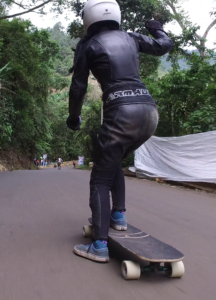
You should learn how to footbrake asap
Footbraking is the easiest and safest way to slow down. If you learn to footbrake, you can quickly gain the confidence to go really fast on your skateboard and still feel confident you can slow down.
There are two main types of footbraking:
- The normal foot brake. You stand on your board and take your back foot out and lightly push it into the ground to slow your speed. This is great for low speeds and if you’re not really bothered with slowing down as much as possible. Check out the image to the right for an illustration.
- The ‘swiss’ foot brake. You crouch down on your board and grab it with your front hand. You take your back foot off and put it on the ground. This technique allows you to really put your weight into your foot and it can slow you down really well. It is also really stable and you can do it when going fast. Check it out in the picture below.
 Some beginners have been able to go 60mph and then slow down using the swiss foot brake. It is a confidence booster for sure.
Some beginners have been able to go 60mph and then slow down using the swiss foot brake. It is a confidence booster for sure.
You should learn to slide eventually, but it will take time, I recommend foot braking first so you can actually go fast without worrying about how you’ll slow down. You can also use it in emergency situations, where sliding wouldn’t be the best move.
Get the right skateboard trucks
In my opinion, trucks around 45* make sliding and learning to slide easier. They allow for enough lean so you can ‘push’ your board as opposed to ‘sitting’ on top of it in the slide.
Trucks with rake have more “bite”. This means they hookup and breakout (slightly) harsher than trucks without rake.
It’s true that loads of people have learned to skate with raked trucks, but I think they’d have learned easier and faster on rakeless trucks. They are some of the best trucks for beginners.
I started DH skating on Paris 50* trucks. They have rake.
They were really grippy and made it hard for me to slide. I tried 50/43* setup later, but even that was just as hard to make breakout and slide easy. Later I got 44* Cals which made it a lot easier to slide.
THAT SAID. I think I had my Paris trucks setup badly? Got some Paris Savants I’m testing now. So the argument of whether I like rake or not will be settled.
What about a split setup?
Split setups are really stable and are recommended for beginners who want to go fast but haven’t developed the skills to handle the speed.
They are basically having a higher angle truck in the front and a lower angle truck in the back.
In a nutshell, they make your skateboard act more like a car – with the front turning and the back only following. This makes them less prone to wobbling. They are very stable but aren’t the best for learning to do slides with.
If you can learn to swiss footbrake, you can use a split setup to go fast and make it down big mountains roads.
Update: Another benefit is they allow you to run looser trucks but still be stable at speed.
Don’t ride your trucks too tight
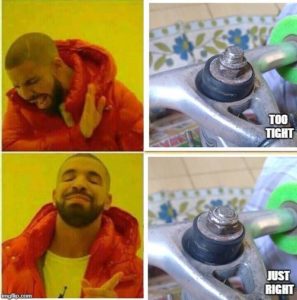 If they are looking to be more stable on a longboard, most people tighten their trucks.
If they are looking to be more stable on a longboard, most people tighten their trucks.
If you tighten your trucks too much, yes you’ll be more stable but you won’t be able to use the full swing of your truck. This limits how much lean and turn you’ll have, meaning your truck won’t perform at it’s best, or how it was designed to work.
If you want a truck that feels tighter, get some harder bushings or washers for more stability and different feels.
That said, if you run your trucks with too hard bushings (or too soft) you won’t have optimal performance. Whilst it is a personal thing, I believe beginners should learn on trucks that are in the middle ground.
Too tight, you won’t have good leverage over your wheel for slides. Too loose and you won’t have a good center point to balance in the slides.
Yes, tight trucks will make you feel more stable but they will not make you a better skater.
You can decide how you want your trucks to feel after a bit more riding experience.
Don’t skate too long of a board
Boards that have a huge wheelbase are more stable yes. But I have found them to be harder to control coming in and out of slides.
Boards with a shorter wb 24-26, will be easier to control and are a good place for a beginner downhill skater to start.
Get a drop down board.
Drop down boards are what I recommend to beginners. They are basically decks where the standing platform is lower than where the trucks are mounted.
They make sliding a lot easier, are stable and they feel really comfortable. What more could you want?
Consider working on your flexibility
A lot of the slide positions may not feel natural for everyone
This has probably hindered my learning the most, as my flexibility has been terrible in the past. A lot of the sliding positions feel natural now but only felt awkward back then because my body couldn’t comfortably get into those positions. Stretching allows you to quickly make those positions feel natural and makes you progress faster.
I think it is the one thing outside of skating you can do to help you get better quickly.
Going to do an article/video on my favorite stretches for downhill later on so keep an eye out on this space.
The first picture of me below is from when I started learning to slide. I had no lower body flexibility and I couldn’t do a heelside slide. It actually hurt to get into the squat position.
On the bottom is a more recent picture. At this point, I had been regularly stretching and working to get comfortable into the squat position. It feels a lot more natural now.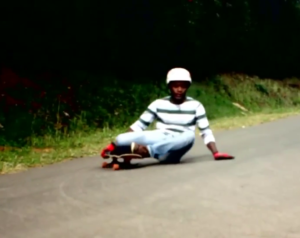
Stretch before and after every session
Dynamic stretches before and static stretches after each skate session.
Dynamic stretches are really easy and take you about 5min to do. They include things like 20 lunges and 20 frog walks and 20 front and back leg swings before each session. They are really quick and easy to do and work well to loosen and warm up your body.
With static stretches, you want your body to be warm so you can stretch deeply and effectively. It’s best you do them at the end of each session as you can injure yourself when you are cold.
They include things like touching your toes, stretching your arm etc. Check out the exact program I use after each session to open up and stretch my hips. It
Make sure you have enough energy left over to stretch effectively. If you skip on stretching, you’ll be stiff the next day/session and you’ll lose quite a bit of flexibility.
Find others and practice with them – take advantage of our amazing community
Ideally, you want to find an experienced mentor and someone who is learning as well. The mentor will be insightful, whilst you and your fellow learner share tips on how you’ve successfully done this and that. You can both help each other learn quicker.
If you can’t find either, it’s ok. Just send it on your own and watch loads of videos. You can learn just as fast and enjoy yourself just as much.
We have one of the best and most supportive communities. If you find a group, people would be more than willing to let you try out their gear, share tips and invite you to sessions.
Which tip was most useful for you?
A lot of these tips will not be easy to follow. However, if you do follow them, you will find your rate of progress will increase.
As challenging as it is, downhill skateboarding is a really rewarding hobby. There is nothing quite like being able to skate down a steep mountain road.

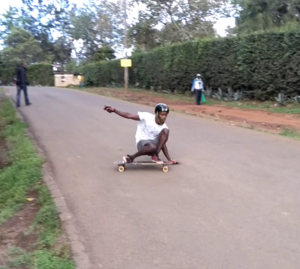
16 comments on “11 tips for beginner downhill longboarders/skateboarders”
Andy Sp8
January 31, 2019 at 7:26 pmGreat article Bugsy…… Very useful info…..
admin
January 31, 2019 at 7:28 pmThanks Andy! Happy you think so bro
Justin
January 31, 2019 at 10:18 pmStellar guide. Can’t wait for the snow to go away so I can give sliding another shot this season.
admin
January 31, 2019 at 10:35 pmOr you could just move somewhere a bit more tropical hehe
@Greg_Hub
January 31, 2019 at 10:30 pmI feel exactly the same about stretching : nothing outsitde skating (or even skating itself) has improved my skills ; a few weeks of daily stretch make a HUGE difference.
I have the same kind of before / after photos 🙂
admin
January 31, 2019 at 10:35 pmStretching changed my life man! Back pain, stiff muscles, all that shit went away
Jackson
February 1, 2019 at 12:31 amI will on Martha’s vineyard which is very, very flat. My setup isn’t the greatest for downhill (drop through symmetrical sector 9 hex drop , butterballs and stock gullwings) but regardless of that it’s just very hard to gain speed here. The fastest I can get going anywhere here is like 30 mph, which makes it hard to progress. I suppose I could just work on slides more (I can only do some basic glove downs), but it’s hard to stay focused with very few hills.
admin
February 1, 2019 at 1:00 amTbh, where I am based we don’t have the greatest variety of hills. What has kept me sane and kept me progressing is simply finding a variety of challenging corners and skating them until I feel satisfied that I can take the best line 8/10 times I skate it (still not satisfied haha).
That said, a lot of skaters do travel far to get to good hills. I really recommend you find a community near you so you have people to travel with to spots.
Brandon
February 1, 2019 at 2:13 amAwesome blog dude, love your posts and how much stoke you spread
Hope to see you do a North American tour soon 😉 lots to see!
admin
February 1, 2019 at 2:44 amI appreciate the kind words Brandon 🙂
I am also hoping for that haha. Just have to make it happen
Noah
February 1, 2019 at 2:12 pmAwesome article, found it incredibly useful! Would u be able to write precisely what stretches you do before and after? Is it only the ones in the article linked? Does it include static and dynamic? How much of each?
Cheers, and thanks for the article
admin
February 1, 2019 at 2:56 pmHey, glad you like the article!
Will upload an article or a video with the exact stretches I use.
The article/video I posted has a few of the ones I use but not all.
Keep an eye out for it, or sub to our youtube channel.
Fay Shandro
June 5, 2019 at 9:13 amWONDERFUL Post.thanks for share..extra wait … SB Com
check it out
June 11, 2019 at 11:54 pmI simply want to say I am newbie to blogging and really loved you’re blog. Most likely I’m going to bookmark your website . You actually have fantastic articles. With thanks for sharing with us your blog site.
Ojoom Pucks
October 5, 2019 at 7:19 pmGreat stuff! Keep up the good work!
AbugaA
October 6, 2019 at 7:43 pmThank you!